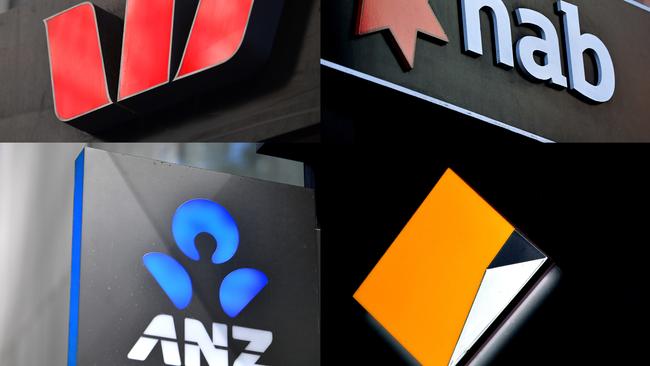Coronavirus: Bank shares battered amid bad debt fears
A surge of customer interest in bank hardship packages has intensified fears of a huge blowout in bad debts.

A surge of customer interest in bank hardship packages has intensified fears of a huge blowout in bad debts, prompting another share-price rout for the major banks.
Commonwealth Bank said it had a 300 per cent increase in calls by late Monday morning, while 250 customers of a big four rival inquired about the six-month deferral of mortgage payments announced by the majors on Friday.
This compared to the usual 5-10 calls a day.
“The increase is from a small base but everyone knows where this is headed,” a senior banker told The Australian.
Bank share prices tumbled in another day of carnage on the sharemarket, amid heightened investor nervousness about rising unemployment leading to a spike in loan impairments across consumer and business lending portfolios.
Goldman Sachs said it was now forecasting a 6 per cent contraction in the domestic economy in 2020 — the biggest since the 1920s Great Depression — with unemployment peaking at 8.5 per cent.
On the upside, the strength of Australian bank balance sheets in terms of funding, liquidity and capital left them “significantly less vulnerable than compared to any point in the recent past”.
“Similarly, the source of historic loan losses for banks — corporate balance sheets — enter this downturn in a better condition than at any point in the last 40 years, with close to all-time-low levels of gearing and all-time low debt-servicing ratios,” Goldman said.
But given the scale of the forecast contraction, bad debts were now expected to rise significantly to 50bps of loans and slash bank earnings by 20 per cent.
A hard-landing scenario would wipe out between 50-70 per cent of the sector’s earnings.
The havoc in the equities market on Monday was partly triggered by a cleansing statement that accompanied National Australia Bank’s conversion of $750m of hybrid capital into ordinary shares.
NAB said the 7.5 million notes issued in March 2015 would convert to 35.1 million shares at a price of $21.34.
While the move was foreshadowed at the bank’s first-quarter trading update, the stock has sunk since then, closing on Monday at $13.88, down $1.78 or 11.4 per cent.
The benchmark S&P/ASX 200 index fared better, shedding only 5.6 per cent to 4546 points. All the big four were marked down heavily, led by ANZ, which retreated $1.92, or 12 per cent, to $14.10.
Westpac slumped $1.67, or 10.6 per cent, to $14.10, and Commonwealth Bank fell $5.65, or 9.4 per cent, to $54.26.
A senior banker said the industry was “shovelling billions of dollars out the door” in efforts to prop up the economy, with the support package announced in conjunction with the government so far worth $189bn, or almost 10 per cent of gross domestic product.
The Australian Prudential Regulation Authority announced it was suspending its regulatory program so it could give its “fullest attention” to the coronavirus outbreak.
The conduct regulator ASIC made a similar move.
APRA chairman Wayne Byres said the nation’s financial system was strong and resilient, reflecting its sound prudenti al framework.
“APRA set out an expansive policy and supervision agenda in January, but right now it is more important that banks, insurers and superannuation trustees — as well as APRA — devote their energy and resources to responding to the impact of COVID-19,” Mr Byres said.
“We will be working with financial institutions to balance the need for timely data and information on current conditions with institutions’ ability to effectively manage their own response.”
In the rapidly evolving environment, he said, APRA would closely monitor the extent and impact of the virus on regulated entities to consider if any further changes to its supervisory and policy activities were necessary.
NAB’s cleansing statement, which preceded the resignation of its business bank boss Anthony Healy, said the pandemic was expected to hit asset quality, leading to increased provisions and risk-weights.
“In particular, we note the current volatility and dislocation in global capital markets may negatively impact on mark-to-market valuations in the markets and treasury portfolios,” the bank said.
In the meantime, the expected duration and magnitude of the pandemic, and its potential effect on the economy, was “unclear”.
Morgan Stanley said in a note that NAB’s markets and treasury income of $1.8bn in 2019 — equivalent to 10 per cent of total revenue — would be broadly flat in 2020.
Impairment charges would rise from 15 basis points of loans last year to 19 basis points this year, and 26 basis points in 2021.
Jefferies analyst Brian Johnson rated NAB as a “buy”, saying the nation’s banks could withstand the current crisis without resorting to dilutive capital raisings at their current depressed share prices.
NAB’s common equity tier one ratio after conversion of its capital notes was 10.78 per cent.
“That’s adequate, all the more so given (prudential regulator) APRA’s indication that it would tolerate slippage below the 10.5 per cent “unquestionably strong” target to facilitate SME lending during the present coronavirus disruption,” Mr Johnson said.
NAB, he said, had noted this in its cleansing statement, saying it anticipated a suspension of the target in the short term to encourage banks to use capital buffers to support additional lending.





To join the conversation, please log in. Don't have an account? Register
Join the conversation, you are commenting as Logout